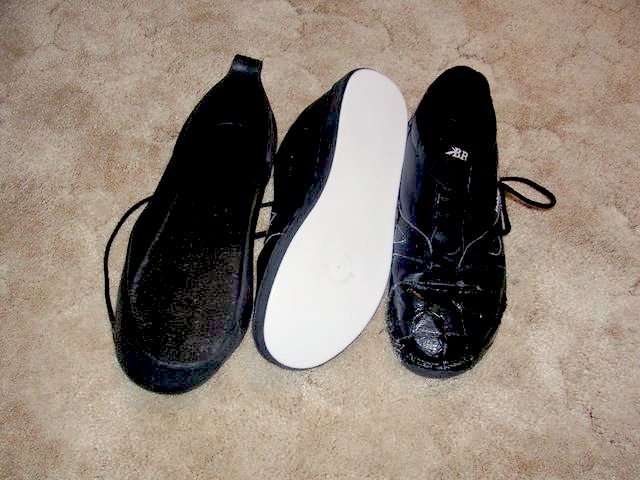Curling shoes are similar to ordinary athletic shoes except that they have dissimilar soles; the slider shoe is designed for the off foot (or sliding foot) and the non-sliding shoe for the hack foot.
The slider shoe is designed to slide and typically has a Teflon sole. It is worn by the thrower during delivery from the hack and by sweepers or the skip to glide down the ice when sweeping or otherwise traveling down the sheet quickly. Stainless steel was once common for slider soles, and "red brick" sliders with lateral blocks of PVC on the sole are also available. Most shoes have a full-sole sliding surface, but some shoes have a sliding surface covering only the outline of the shoe and other enhancements with the full-sole slider. Some shoes have small disc sliders covering the front and heel portions or only the front portion of the foot, which allow more flexibility in the sliding foot for curlers playing with tuck deliveries. When a player is not throwing, the player's slider shoe can be temporarily rendered non-slippery by using a slip-on gripper. Ordinary athletic shoes may be converted to sliders by using a step-on or slip-on Teflon slider or by applying electrical or gaffer tape directly to the sole or over a piece of cardboard. This arrangement often suits casual or beginning players.
The non-sliding shoe, or hack foot shoe, is worn by the thrower on the hack foot during delivery and is designed to grip. It may have a normal athletic shoe sole or a special layer of rubbery material applied to the sole of a thickness to match the sliding shoe. The toe of the hack foot shoe may also have a rubberised coating on the top surface or a flap that hangs over the toe to reduce wear on the top of the shoe as it drags on the ice behind the thrower.
Curling was invented in medieval Scotland, with the first written reference to a contest using stones on ice coming from the records of Paisley Abbey, Renfrewshire, in February 1541
The slider shoe is designed to slide and typically has a Teflon sole. It is worn by the thrower during delivery from the hack and by sweepers or the skip to glide down the ice when sweeping or otherwise traveling down the sheet quickly. Stainless steel was once common for slider soles, and "red brick" sliders with lateral blocks of PVC on the sole are also available. Most shoes have a full-sole sliding surface, but some shoes have a sliding surface covering only the outline of the shoe and other enhancements with the full-sole slider. Some shoes have small disc sliders covering the front and heel portions or only the front portion of the foot, which allow more flexibility in the sliding foot for curlers playing with tuck deliveries. When a player is not throwing, the player's slider shoe can be temporarily rendered non-slippery by using a slip-on gripper. Ordinary athletic shoes may be converted to sliders by using a step-on or slip-on Teflon slider or by applying electrical or gaffer tape directly to the sole or over a piece of cardboard. This arrangement often suits casual or beginning players.
The non-sliding shoe, or hack foot shoe, is worn by the thrower on the hack foot during delivery and is designed to grip. It may have a normal athletic shoe sole or a special layer of rubbery material applied to the sole of a thickness to match the sliding shoe. The toe of the hack foot shoe may also have a rubberised coating on the top surface or a flap that hangs over the toe to reduce wear on the top of the shoe as it drags on the ice behind the thrower.

